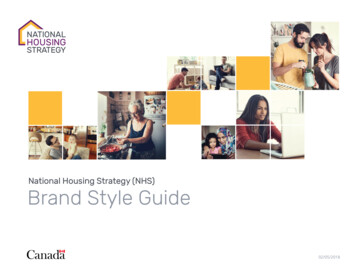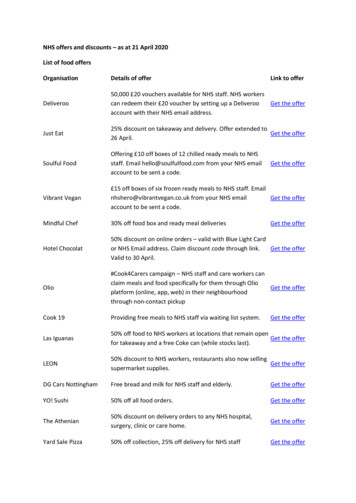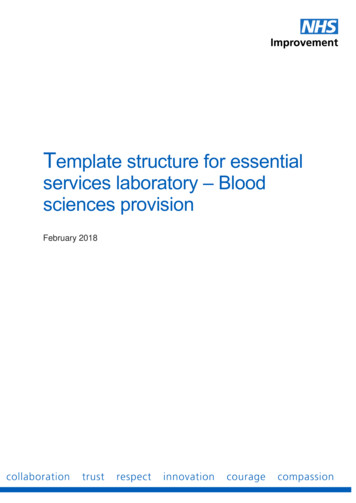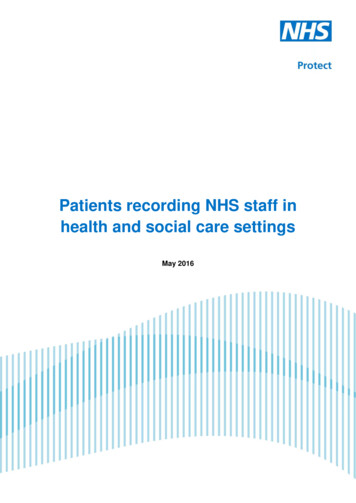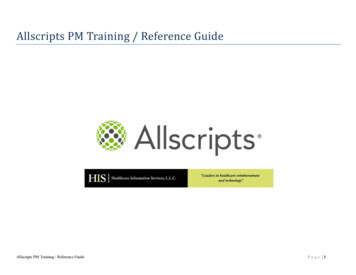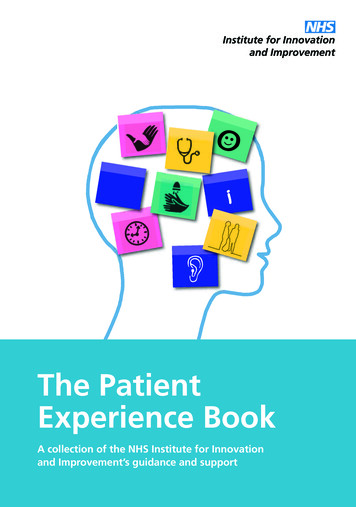
Transcription
The PatientExperience BookA collection of the NHS Institute for Innovationand Improvement’s guidance and support1
The PatientExperience BookA collection of the NHS Institute for Innovationand Improvement’s guidance and support
Copyright NHS Institute for Innovation and Improvement 2013The Patient Experience Book is published by the NHS Institute for Innovation and Improvement,i-House, University of Warwick Science Park, Millburn Hill Road, COVENTRY, CV4 7HS.Copyright in The Patient Experience Book belongs to the NHS Institute for Innovation andImprovement.Any third party concepts and trademarked devices have been reproduced in this document with thepermission of the respective copyright/IP owners. All rights reserved.This publication may be reproduced and circulated by and between NHS England staff, relatednetworks and officially contracted third parties only, this includes transmission in any form or by anymeans, including e-mail, photocopying, microfilming, and recording. All copies of this publicationmust incorporate this Copyright Notice.Outside of NHS England staff, related networks and officially contracted third parties, thispublication may not be reproduced, or stored in any electronic form or transmitted in any form or byany means, either in whole or in part, including e-mail, photocopying, microfilming, and recording,without the prior written permission of the NHS Institute for Innovation and Improvement,application for which should be in writing and addressed to the Marketing Department (and marked‘re. permissions’). Such written permission must always be obtained before any part of thispublication is stored in a retrieval system of any nature, or electronically.Any unauthorised copying, storage, reproduction or other use of this publication or any part of it isstrictly prohibited and may give rise to civil liabilities and criminal prosecution.ISBN: 978-1-907805-28-8
About the NHS Institute for Innovation andImprovementThe NHS Institute was established in July 2005 to support thetransformation of the NHS, through innovation, improvement and theadoption of best practice. We enable and support the NHS system totransform health and healthcare for patients through a strategy of creatinginventive, clinically-led and tested practical ideas which will build skills andcapability for continuous improvement.On 1 April 2013, NHS Improving Quality is being established to bringtogether the wealth of knowledge, expertise and experience of a numberof NHS improvement organisations. NHS Improving Quality will be hostedby the NHS Commissioning Board.Why we have published this bookChange is the inspiration for this book. On 2 April 2013, a number ofpeople working across the health system will be in new roles, perhaps innew organisations. Those remaining in their existing roles will need tocommunicate and work with any new organisations that have beenestablished. We wanted to pull together our ‘institutional memory’ andhand it over to everyone who will be working in the new landscape toimprove the experiences of people who use health and social care services,their carers and their families. This book is, therefore, a legacy publication.At the NHS Institute, we have worked on a number of programmes anddeveloped materials that aim to support the NHS to improve patientexperience, in particular: the Patient Experience Learning Programme; theTransforming Patient Experience: essential guide; and the NHS PatientFeedback Challenge. In this book, and the CD that accompanies it, wehave included a range of content and materials from these programmes.1
This book is for people with designated responsibility for improving patientexperience – both as providers of services and as commissioners. It isintended to give you the evidence you need to influence others, both atmanagement/board level and team level, to focus on improving patientexperience.The content that follows provides a rich source of research evidence, storiesfrom patients and staff and many examples of innovation. It also illustratesa range of well-tested techniques to help you work more closely withpatients to understand their experience and use these insights to improveservices.2
Thank youWe would like to thank everyone who has worked with us over the years:the patients and family members who have brought their fresh eyes,insights and challenge to our work; the Department of Health which hassupported this agenda and ensured investment; our colleagues across thecountry who have helped us to co-design what we hope are useful andpractical products; our colleagues in the NHS Institute who have alwayscontributed their imaginative and innovative insights and professionalservices; and other partner organisations that have been vital to thesuccess of our programmes.3
ForewordImagine an NHS service that starts with the patient – a service that listensto patient and family needs, and then utilises the skills and expertise ofboth the clinician and patient to design the experience to meet theseneeds. That’s what using patient experience information is all about.Ultimately by consistently asking people whether they are receiving thecare they need and then improving things on the basis of what they tellyou will help patients feel more supported and better cared for.We have reached a seminal point in our efforts to improve the experienceof people who use health and social care services, and their families.If you have been working hard to promote patient engagement andexperience, you will be only too aware that never before has this area ofwork had such a high profile.Only a few years ago, you might have focused your efforts on trying toconvince people in ‘your local area’ of the health and social care system tofocus on patient experience as much as on clinical effectiveness or safety.Now, the need to improve experience is widely acknowledged in policy,rhetoric and in the new systems and structures.There have been a number of things that have brought about this shift. Ata policy level, the work of Lord Darzi in 20081 signalled a need to considerexperience alongside safety and quality. This was further cemented by theintentions expressed in the Equity and Excellence: Liberating the NHS2010 White Paper2. Alongside this, the Francis report into care failures atthe Mid Staffordshire NHS Foundation Trust3, published on 6 February2013, puts the spotlight on the cultural, leadership and system changesthat are needed across the NHS.The question now is, how can we make the most of this opportunity tomake a real difference for patients and how can we maintain themomentum of that need to change? It is clear that a culture change is1High Quality Care for All report, 30 June 2008 v63http://tinyurl.com/c3y6p84 , http://tinyurl.com/cepy73t4
required and, with the Friends and Family test4 being implemented inhospital settings this year, closely followed by community settings, theexpectation of seeking feedback on services and seeing positive changeas a result can only increase.Any programme intended to improve patient experience needs to influencethe behaviours both of staff who have direct patient interaction (such asreceptionists, nurses, doctors, porters) and those who work more indirectly(such as managers and corporate staff).Providers of services and the groups that commission them will need towork in partnership with one another. The development of a newlandscape for commissioning is an ideal opportunity to learn from existingeffective practice and build on it in innovative ways. In fact, it could beargued that the most ‘innovative’ thing commissioners can do is to findthe evidence-based practice and encourage it to be adopted elsewhere.What the NHS Institute found when it introduced the NHS PatientFeedback Challenge is that, often, we know what works and there arepockets of excellence, but it is spreading this practice elsewhere that posesthe biggest challenge. Commissioners are in a position to act as rolemodels – by understanding what is important to patients in their local area(for example, by setting up systems that enable them to have meaningfulconversations) and how the process of better understanding patientexperience can be a tool for service improvement and a lever forperformance. Commissioners will need to work in partnership with thevoluntary sector, patient groups, communities and health and social careservices to set realistic goals that enable organisations to implementprogrammes and sustain improvement.One of the most important lessons I have learnt in the last few years is thathealth organisations need to be ambitious. The experience we deliver forpatients and their families will only ever improve when an entireorganisation or health and social care system examines and re-creates itsculture, leadership, service user engagement, staff engagement andmeasurement systems in order to improve service experience.4A mandate to ensure that people have a positive experience of care http://tinyurl.com/bvwu54a5
An incredible amount of information about what works already exists andhundreds of people have helped to create the knowledge bank representedin this book, and in the guidance and organisations we reference. I hopethat what follows will inspire and energise you to continue the brilliantwork that you have already started.Sam HudsonHead of Experience and EngagementNHS Institute6
ContentsSection one:What is Experience?Section two:Why Should we Improve Patient Experience?814Section three: Who Needs to be Involved in ImprovingPatient Experience?27Section four: How to Improve Patient Experience34Section five:NHS Institute Tools that Can Help YouImprove Experience52Section six:Measuring Experience58Section seven: Commissioners and Patient Experience73Section eight: The NHS Patient Feedback Challenge80Section nine: The Patient Experience Learning Programme83Section ten:88Over to you.The Patient Experience CD index897
The Patient Experience BookSection one: What is Experience?On the face of it, experience can seem quite simple. We all haveexperiences every day, both good and bad, but have you noticed that thebetter or worse the experience is, the more people you tell? It’s true thatwe all experience things slightly differently and each experience itself ismade up of a number of experiences, or ‘moments’, that are all measuredagainst our original expectations. In the retail, travel and hospitalityindustries, these ‘moments’ are big business and often, without usconsciously realising it, our senses are stimulated and emotions evoked bythese carefully orchestrated ‘moments’. NHS services have the potential todo just that – to plan for experience.‘Patient experience’ is what the process of receiving care feels like for thepatient, their family and carers. It is a key element of quality, alongsideproviding clinical excellence and safer care. The way that the health systemdelivers its care and support services – from the way the phone isanswered, to the way the GP examines them or the nurse explains what ishappening – has an impact on the experience the patient has. If safe careand clinical excellence are the ‘what’ of healthcare, then experience is the‘how’. Starting with the patient, listening to their needs, and designing theexperience to meet these needs is achievable and results in an environmentwhere individual patients feel cared for and supported.If you think back to your lastinteraction with a healthservice, either as a patient,family member, carer orfriend, can you rememberhow you felt and what madeyou feel like this? Now,imagine an NHS service thatstarts with the patient – aservice that listens to patientand family needs, and thenutilises the skills and expertiseof both the clinician and8
Section one: What is Experience?patient to design the experience to meet these needs. It sounds like anappealing idea.While we may aspire to this on a human level, as healthcare providers itcan feel overwhelming – how on earth can the service respond to all ofthese differing patient needs? How can it provide a positive experience forall patients? And, more importantly, how can it support the provision ofcare generally, including social care? This book sets out to answer thesequestions and show how you can work to improve the experience of allpatients in your service.Understanding patient experience and engagement –what’s the difference?The language barrierRecent research commissioned by the NHS Institute (Gill Ereaut, LinguisticLandscapes, 2013) in partnership with National Voices5, has revealed thatthe language we use to try and describe this desire for a differentrelationship with the people who use health services is often confusing andhas some significant features:5http://www.nationalvoices.org.uk/9
The Patient Experience Book Lots of different terms are used and these are often combined– forexample ‘Patient and Public Involvement and Engagement’ (RCN);‘Patient and Public Voice and Information’ (NCB); ‘Patient and PublicExperience and Engagement’ (a network). Terms seem to be piled uplike this because none of them quite expresses what people areseeking to do.These terms have not been found to be engaging, are often felt tobe confusing, and seem to have been unable to help bring aboutreal change.The language changes all the time and the terms used are alsoinconsistent in meaning, even amongst those within the field.The language contains abstract nouns, for example; engagement;involvement; slogans such as ‘no decision about me without me’;and jargon or hard to decipher terms such as co-production – all ofwhich make it harder for people to understand what they need todo to make change happen.So, the language we use to talk about “patient experience andengagement” acts as a distraction from the important issues ofprofessional boundaries, power sharing and the allocation of resources.The impact of this is that, although the intention behind the language is tosupport real change in the relationship between people and the healthsystem, the language ends up supporting the status quo. Being aware ofthis and questioning our language is the first step towards making thosereal issues more visible.10
Section one: What is Experience?A definition: what do we mean by patient and publicengagement and patient experience?It is sometimes helpful to think of patient experience and engagementactivities existing on a continuum, where the amount of influence peoplecan have over decisions ershipPatient and public engagement is the active participation of patients,carers, community representatives, community groups and the public inhow services are planned, delivered and evaluated. It is broader and deeperthan traditional consultation. It involves the ongoing process of developingand sustaining constructive relationships, building strong, activepartnerships and holding a meaningful dialogue with stakeholders.Engaging with patients and the public can happen at two levels: individual level – ‘my say’ in decisions about my own care andtreatmentcollective level – ‘my’ or ‘our say’ in decisions about commissioningand delivery of services.Effective patient engagement means involving patient cohorts (patientswith common conditions) in helping to get the service right for them. It isalso about engaging the public in decisions about the commissioning,planning, design and reconfiguration of health services, either pro-activelyas design partners, or reactively, through consultation.Effective engagement leads to improvements in health services and is partof everyone’s role in the NHS.11
The Patient Experience BookA definition: what is patient experience?Patient experience is what the process of receiving care feels like for yourpatients. Understanding patient experience can be achieved through arange of activities that capture direct feedback from patients, service users,carers and wider communities. These are used alongside information onclinical outcomes and other intelligence to inform quality improvements,the way local services are designed and reshaped, and contractualarrangements with providers.There are many different ways to understand the experiences of patientsand carers – from questionnaires or analysing complaints, through toExperience Based Design approaches6. Using experience to design betterhealthcare is unique in the way that it focuses so strongly on capturing andunderstanding patients’, carers’ and staff experiences of services, not justtheir views of the process.“Getting good treatment in a comfortable, caring and safeenvironment, delivered in a calm and reassuring way; havinginformation to make choices, to feel confident and feel in control;being talked to and listened to as an equal; and being treated withhonesty, respect and dignity”.Department of Health (2005) ‘Now I feel tall –what a patient-centred NHS looks like’6www.institute.nhs.uk/ebd12
Section one: What is Experience?What this book covers: patient experienceIn this book, we focus on patientexperience – how to understand itand how to use it effectively toimprove services, and as a lever forperformance management.There is a great deal of work goingon across health services to engagepatients in decisions about theirown care, about the running ofservices and, increasingly, theprioritisation of services. As withpatient engagement, patientexperience activities need tofocus on helping people tounderstand the competing pressures within thehealth system, as well as understanding the ways in which improvingpatient experience, clinical effectiveness and safety are connected.Organisations embarking on patient experience work to improve servicesneed to understand both why and how. So, we have set out the case forunderstanding patient experience,with reference to relevant researchevidence and the national policyframework.The next section of this bookexplains why various parts of thehealth system should improve theexperience of patients in theircare. From section four onwards,you can read about how toimprove patient experience.13
The Patient Experience BookSection two: Why Should weImprove Patient Experience?Making the case for changeImproving patient experience is about working with the people who useservices to make these services better. It is about designing services thatmeet their needs and it requires a commitment to doing this on anongoing basis, day-by-day and year-by-year. Evidence from the commercialsector and from across health services shows that the staff who work inthe system, at all levels, need to be engaged in the improvement processfor it to work.Evidence from healthcare organisationsThere is a growing body of evidence (see Supporting research below) toconvince business leaders across the service of the importance of investingin improving patient experience. It is likely that structures, such as the NHSCommissioning Board, the new Improvement Body, the NHS TrustDevelopment Authority and Healthwatch England will continue to add tothis body of evidence. This evidence illustrates: 14the impact of experience on organisational reputation (ie if patientshave a poor experience of care it can damage an organisation’sreputation)that experience is improved when people have more control overtheir care and the ability to make informed choices about theirtreatmentthe link between experience and health outcomes (ie patients whohave a better experience of care generally have better healthoutcomes)the link between experience and cost of care (ie poor experiencesgenerally lead to higher care costs as patients may have poorer
Section two: Why Should we Improve Patient Experience?outcomes, require longer stays or be readmitted for furthertreatment) the relationship between staff and patient experience (ie if patientsare having a poor experience, it has a negative impact on staffexperience as well).Supporting research1. Feeling better? Improving patient experience in hospitalThe report entitled Feeling better? Improving patient experience inhospital, NHS Confederation, 20107 provides compelling evidence thathospital boards can achieve better outcomes across their entireorganisation when patient experience is a priority.It contains seven inspiring case studies of organisations that haveundertaken patient experience work and concludes that there are anumber of factors that are common across all of the organisationsfeatured. These include: transformational leadership whole-system change patients and families that are engaged in care 7an emphasis on continual feedback from patients, families andcarers, and measurement for improvementan integrated programme of activities, rather than a series of small,random projectsa recognition of the importance of embedding desired values andbehaviours across the organisationstaff who are enabled to deliver excellent patient experience andempowered to make changes themselvesgreater clinical engagement and professional empowerment.http://tinyurl.com/a95hykt15
The Patient Experience Book2. Costs and Benefits of Implementing a Patient ExperienceStrategy; Or Why Every Director of Finance Should beInvesting in Patient ExperienceThe Excellence Framework forPatient Experience forms partof a wider piece of work onpatient experience,commissioned by theDepartment of Health andNHS Northwest. Its reportCosts and Benefits ofImplementing a PatientExperience Strategy; OrWhy Every Director ofFinance Should be Investing in Patient Experience8 makes themanagement case for investing in patient experience, proposing that thereare sound management and financial reasons for doing so. It points outthat patient experience is now a central issue for the NHS CommissioningBoard, Clinical Commissioning Groups and service providers. The WhatMatters to Patients? research, explained below, has also shown that isimperative that we start to collect evidence of the link between experienceand the cost of care.8http://tinyurl.com/c8u2wng16
Section two: Why Should we Improve Patient Experience?3. What Matters to Patients?In 2010, the Department of Health and the NHS Institute commissionedKing’s College London and The King’s Fund to undertake a research projectentitled: What Matters To Patients? Developing the Evidence Basefor Measuring and Improving Patient Experience9.It was compiled following extensive interviews with patients and carers,patient representative organisations, and NHS organisations, a review ofevidence from the voluntary sector and patient care organisations, a seriesof events, literature reviews and a detailed review of five key conditions,including mental health and long-term conditions. The report covers: what matters to patients? – particularly in the non-acute sectorwhat do NHS organisations in England currently measure in relationto what really matters to patients?examples of NHS organisations that are using information andinsights into patient experience to improve the quality andproductivity of healthcare services.The report also includes an annex comprising: a literature review, a surveyof voluntary organisations, patient and carer interviews, qualitative andquantitative analysis of NHS Choices datasets, quantitative analysis ofPatient Opinion ratings, organisational case studies and the nationaltraining survey.9http://tinyurl.com/cc6rtu717
The Patient Experience BookBoth The Main Report10 and The Policy Recommendations11 are on the CD(in the What Matters to Patients folder) that accompanies this book.Key findings from What Matters to Patients?Functional versus relational aspects of careOne of the key findings from interviews with patients with long-termconditions (as shown in the table below) was that it is the relationalrather than the functional aspects of their care that matter most to them.Relational aspects of care include feeling listened to, or informed, while‘functional’ refers to the process of delivering care, such as efficientprocesses. This research shows us very clearly that patients care about theirexperience of care as much as clinical effectiveness and safety. People valueefficient processes, they want to feel informed, supported and listened toso that they can make meaningful decisions and choices about their care,and the one thing we hear again and again is they want to be ‘treated as aperson, not a number’.The health service has tended to concentrate on improving functionalaspects of care, yet this research reveals clearly that the relational aspectsof care matter as much to url.com/bmhg7jv18
Section two: Why Should we Improve Patient Experience?Treating patients as peopleBut, what does being ‘treatedas a person’ mean in practicefor patients and how can wemake it a daily reality for thehealth service?It is about training andfocusing on staff deliveringthe relational aspects of care,such as: good communication,emotional support, respect,empathy, involvement in decisions and good information provision. This hasto happen alongside the development of systems that support the functionalaspects of care, like joined-up services and providing physical comfort.Effective measurement is vital – see section six: Measuring Experience formore information.4. The King’s Fund Point of Care programmeThe King’s Fund Point of Care Programme12 aims to help healthcare staff inhospitals to deliver the quality of care they would want for themselves andtheir own families. The programme works with patients and their families,staff and hospital boards to research, test and share new approaches toimproving patient experience.5. Always Events from the Picker InstituteThe Picker Institute is dedicated to enhancing the delivery of patient-centredcare across healthcare. Picker has devised Always Events which can help thesystem to become more patient-cantered13. These were in contrast to thewell-known Never Events, which refer to incidents that should never happenin the delivery of care, patient-focused Always Events are aspects of thepatient and family experience that should always occur when patientsinteract with healthcare professionals and the delivery t-care13http://alwaysevents.pickerinstitute.org19
The Patient Experience BookThemes from patient interviewsBeing treated as a person, not a numberStaff who listen and spend time with patientIndividualised treatment and no labellingUsing language that is easy to understandFinding out about the latest technologies and innovations medicationsFeeling informed, receiving information and being given optionsPatient involvement in care and being able to ask questionsMore public awareness about conditionEfficient processesKnowledgeable health professionalsAftercare supportPositive outcomesContinuity of careGood relationships and positive attitudes among staffThe value of support services20Functional Relational
Section two: Why Should we Improve Patient Experience?Policy Drivers“Patients, users and carers are the reason for the NHS existing and, as such, must be at the centre of all that the NHS and itsstaff do.”National Quality Board, February 20101. The NHS ConstitutionThere are a number of relevant policy documents, drivers, incentives andsanctions that make improving patient experience an imperative, and auseful place to start is always the NHS Constitution. The NHS Constitutionwas created to protect NHS England and ensure that it will always do thethings it was set up to do in 1948 – to provide high quality healthcare thatis free and for everyone.The Constitution establishes the principles and values of high qualityhealthcare and sets out the rights to which patients, public and staffare entitled.21
The Patient Experience BookOne of the seven key principles is that the NHS aspires to the higheststandards of excellence and professionalism:“In the provision of high quality care that is safe, effective andfocused on patient experience; in the planning and delivery of theclinical and other services it provides; in the people it employs andthe education, training and development they receive; in theleadership and management of its organisations; and through itscommitment to innovation and to the promotion and conduct ofresearch to improve the current and future health and care of thepopulation.”Providing a poor service costs money and it is clear, from current feedback,that the NHS is not yet providing a consistently positive experience.2. NICE Quality Standards for Patient Experience in Adult NHSServicesTo deliver the best possible experience for patients who use NHS Services,high quality care should be clinically effective and safe. Launched inFebruary 2012, these quality standards and accompanying clinical guidanceaim to ensure that patients have an excellent experience of care fromthe NHS.3. No decision about me, without meThe philosophy of ‘no decision about me, without me’ in the 2010 WhitePaper now sits alongside a number of national policy drivers requiringhealthcare organisations and professionals to continually measure andimprove patient experience, such as the Outcomes Framework14 and theNICE guidelines for patient experience15 and mental health service userexperience16. The aim of these policy imperatives is to provide a patientcentred healthcare service which meets the physical and emotional needsof the .uk/CG13622
Section two: Why Should we Improve Patient Experience?4. NHS Operating Framework 2012/13The NHS Operating Framework 2012/1317 specifically states that the NHSshould collect and use patient experience information in real time and useit for service improvements: ‘NHS organisations must actively seek out,respond positively and improve services in line wi
Why we have published this book Change is the inspiration for this book. On 2 April 2013, a number of people working across the health system will be in new roles, perhaps in new organisations. Those remaining in their existing roles will need to communicate and work with any new organisations that have been established.
